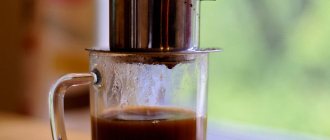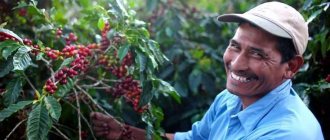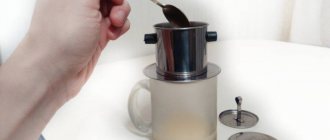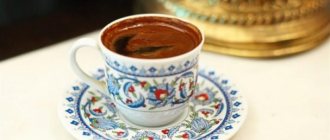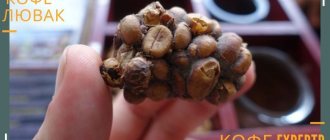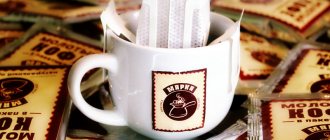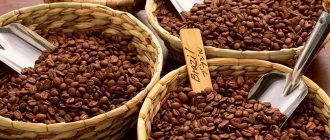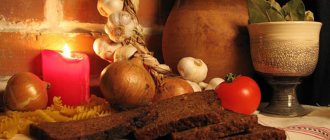Features of national production
In the 18th century, the enterprising Dutch, attracted by the mild tropical climate of the island of Java, decided to plant coffee tree seedlings here. The first Arabica plantings took root in Java just fine. Plantations grew and expanded, technology improved, and the demand for coffee grew. One would think that the tight-fisted Dutch were already rubbing their hands in anticipation of coffee super-profits, but the unexpected happened. Tender trees have been attacked by coffee rust. Over the course of the year, more than 80% of the plantings were destroyed. The remaining trees were simply unsuitable for restoring the coffee population, as they were a hotbed of infection.
Practical settlers approached the issue radically. They destroyed all the old trees and brought new ones from Africa, not so pampered. The Dutch chose robusta for their subsequent agricultural experiments, and they were right. The trees have taken root well and are resistant to rust and other diseases. The humid equatorial climate and organically rich soils softened and enriched the taste of coffee beans.
Today, about 90% of the total Indonesian coffee harvest is Robusta. The country is the largest supplier of grains for mixtures and blends. These beans are also used as a base for making instant coffee.
The structure of the local coffee business includes both large state-owned farms and small farm enterprises. Most often, they fall within the sphere of interests of one family and are passed down by inheritance, along with the secrets of coffee processing.
Coffee from Java
The island of Java currently produces more than ten percent of all Indonesian coffee. Coffee has the most delicate aroma, has a characteristic light sourness, balanced and enveloping.
In Java you can find two types of coffee plantations: state-owned, called Government Estate, and private, called Private Estate.
State coffee plantations include six coffee farms created by the Dutch colonialists. The most famous of them is Blawan. Djampit, Pankur and Kayumas.
The drink, made from Blawan coffee, is thick with a subtle earthy flavor. If the grains are not overcooked, it will leave a bittersweet chocolate aftertaste. What makes Blawan coffee irresistible is the subtle taste of mushrooms. However, in fairness, it must be said that Blawan coffee is very similar in taste to Kayumas coffee.
Indonesian coffee: varieties and varieties
Grains grown in this country are distinguished by place of production and variety.
The main coffee regions in Indonesia are the islands of Java, Sumatra, Sulawesi and Bali. Would you mind a little excursion to these tropical lands?
- Island of Java . It was here that the enterprising Dutch began their activities. Today there are six farms here, which were started by European settlers. All production facilities today are state owned. There are many small family businesses in Java, but they all comply with the necessary government production standards. The peculiarity of the Javanese soil gives the grown coffee a pleasant, light and balanced taste, fruity notes and characteristic sourness. The finished drink is soft and even delicate, with a long, enveloping aftertaste. Among the local varieties, the one that is named after the oldest farm, Blavan, is very popular, where it is still grown. This coffee has a distinctive nutty-earthy note and chocolate aroma.
- Sumatra Island . Several varieties of Arabica are grown here, which is highly valued by coffee lovers. Particularly notable are Mandeling (Medelin) and Ancola. Coffee from Sumatra has a dense, thick, very rich taste, high strength, chocolate bouquet with light, transparent sour-citrus notes. Fans of the strong drink love it.
- Sulawesi Island . It's known for the rich flavor of locally grown coffee, the chocolate and nut flavors of the brew, and the unusual maple syrup note that lingers on the finish. If we talk about popular varieties, then Sulawesi Thoraya receives the most attention. It has dense, strong grains of a greenish color. They do not contain too many polysaccharides, so they hardly darken when fried. The second click of the bean is considered a signal that the heat treatment is complete. If you expect the usual darkening, you may end up with severely overcooked beans.
- Bali Island . Here coffee is grown in small farms that are always open to tourists. Both robusta and arabica grow on plantations, and a mixture of grains or a ready-made blend is exported. Balinese coffee produces a very strong and aromatic infusion. It contains notes of spices, fruits and chocolate, it is thick and viscous.
Development of the coffee industry in the country
Coffee cultivation began in Indonesia at the end of the 17th century. The enterprising Dutch, who were the owners of the islands at that time, brought coffee trees from India just in case, as an experiment, since their main goal at that time was various spices. But when the first harvest was harvested, it became clear that, thanks to ideal natural conditions, the experiment was successful, and already in 1712, coffee grown on the island of Java was sold in Amsterdam with great success.
Arabica coffee plantations soon grew on the islands of Flores, Bali, Sumatra, and Sulawesi. And for almost 150 years then Indonesia occupied the palm in the production of this drink.
But at the end of the 19th century, the rust fungus - the scourge of coffee plantations - destroyed almost all the crops, with the exception of those that grew high in the mountains. Coffee exports declined for many years.
After some time, the Dutch again tried to grow coffee trees, this time, giving preference to Liberica. The species is less whimsical and easier to cultivate. The only thing is that it tastes sharp and bitter, but has a bright aroma. Therefore, Liberica was added to Arabica, and Indonesian coffee became even more aromatic, but lost a little of its velvety quality.
But soon another epidemic of the fungus again nullified all efforts, destroying the plantings. This deprived Indonesia of leadership in the production of the drink for a long time. It was only after gaining independence in 1945 that the country received a new impetus for economic development. The Indonesians began to grow coffee trees again, purchasing the Robusta variety, since it is not susceptible to fungus and produces an excellent harvest.
Kopi Luwak - The Legend of Indonesian Coffee
There are very remarkable pages in the coffee history of this country. For example, this is where one of the most expensive varieties of coffee in the world is made - Kopi Luwak. For this purpose, grains are fed to funny and amusing animals, which are called Luwak in the local dialect. These are small, dexterous and flexible creatures of the civet family, relatives of civets. They readily eat coffee beans. In their digestive system, coffee undergoes partial fermentation.
Naturally removed from the animal’s body, the grains are washed, dried, fried and sold to the world’s most desperate gourmets. The price of a kilogram of such a delicacy costs approximately 30 thousand rubles.
Coffee from Sulawesi Island
Coffee from the island of Sulawesi has a wonderful aroma and rich bouquet. The most famous coffee variety is Sulawesi Toraja. It is characterized by low acidity, excellent infusion and taste, which practically makes a person forget about everything for a long time.
Sulawesi Toraja coffee was formerly known as Celebes Kalossi. Kallosi was the Dutch name for the region of Toraya, an area of dense forests where huge bats hang from the trees and ancient family estates look like ships rather than houses. Coffee trees are grown in small plots around village houses, considered family property. Family traditions of processing the harvested coffee are passed on from generation to generation. This is what makes the coffee unique.
The taste of Sulawesi Toraja coffee is rich, well-balanced, neutral with a pleasant, sweet nutty flavor and an unusual taste of maple syrup. Its consistency is viscous, thick, and the taste is sweetish, one might also say deep earthy and mushroomy, the acidity is somewhat reduced, and the flavors are fruity.
It is important for us as buyers to know that
Bali Shinzan
Indonesia can please coffee lovers not only with the fruits of the intestinal activity of Luwak. True connoisseurs will find here the excellent Bali Shinzan - an Arabica variety that has a very expressive, bright taste and rich color of the finished infusion. It has a distinct taste of herbs and spices, which is generally not very typical for Indonesian coffee. Unusual and long, sweet aftertaste. They say that whoever tastes this drink will never forget its taste. We tend to believe this.
How much does Luwak coffee cost?
On the plantation, Luwak coffee can be purchased for about $15 per 100 grams, and wholesale for about $100 per kilogram.
REFERENCE! In Europe, the cost of coffee made from Luwak excrement has already reached $400 per kilogram; at retail, this coffee can cost up to $100 per 100 grams.
While touring the plantation, I looked at these poor civets who were mostly dozing in their cages. Most of them are quite aggressive, but during the day some of them can be quite friendly and can even be petted and held. They are soft to the touch and fluffy with very cute faces.
Artificially aged coffee
Another Indonesian coffee attraction is artificially aged coffee. It is sold under the brand name "Old Java" or "Old Government". May also be found under the name Old brawn. There may simply be a note on the label - old varieties. If you come across such packaging, be sure to try this coffee. Aging technology is only possible in a humid equatorial climate. The grains acquire a sweetish, deep, viscous taste, and the consistency of the finished drink becomes more viscous and thick.
Coffee from Sumatra
Sumatra is the second largest island of the archipelago. Coffee is produced with a rich “taste body”, dense, which is so appreciated by connoisseurs. Grains from the Mandeling and Ankola plantations are especially highly valued. Among Arabica beans, the beans called “Mandeling” have the thickest flavor intensity.
Characteristics of taste. Bouquet: in Sumatra, coffee is thick, viscous, viscous, “chocolate”. Coffee from the island of Java has a sharper taste, spicy, richly rich, with a slight sourness. Roast: dark medium or dark; Suitable for espresso or blends, ideal for lattes.
Cost of Indonesian coffee
You can purchase coffee beans from this distant and exotic country in specialized stores. Blends and blends of Indonesian coffee are part of popular brands that can even be found on supermarket shelves.
1 kilogram of Medellin or Blavan single-origin beans will cost 1,900 rubles. Aged or, as it is sometimes called, aged Javanese coffee can be found at a price of 2,200 rubles per 1 kilogram.
Have you tried Indonesian coffee? Share your impressions with us!
